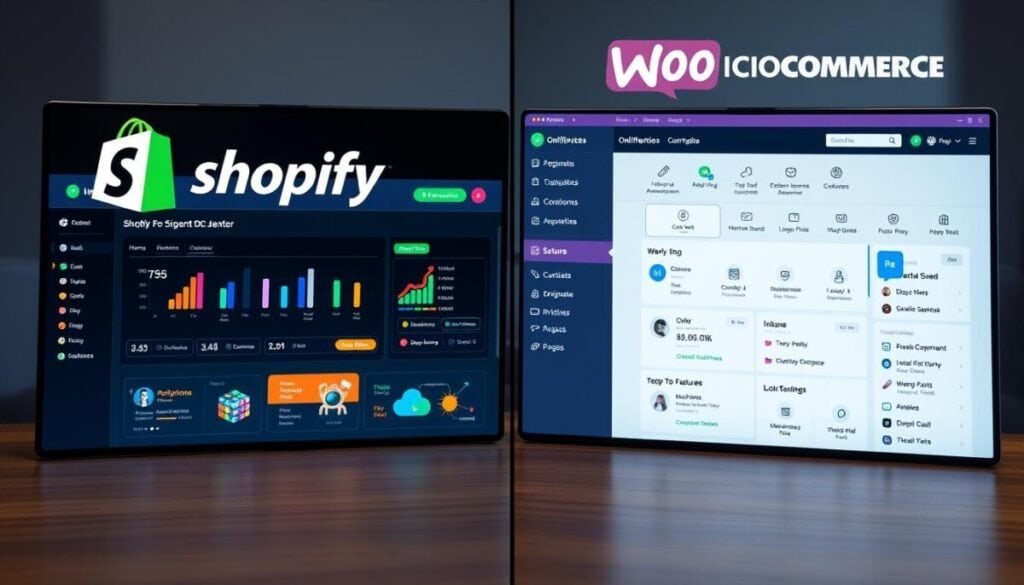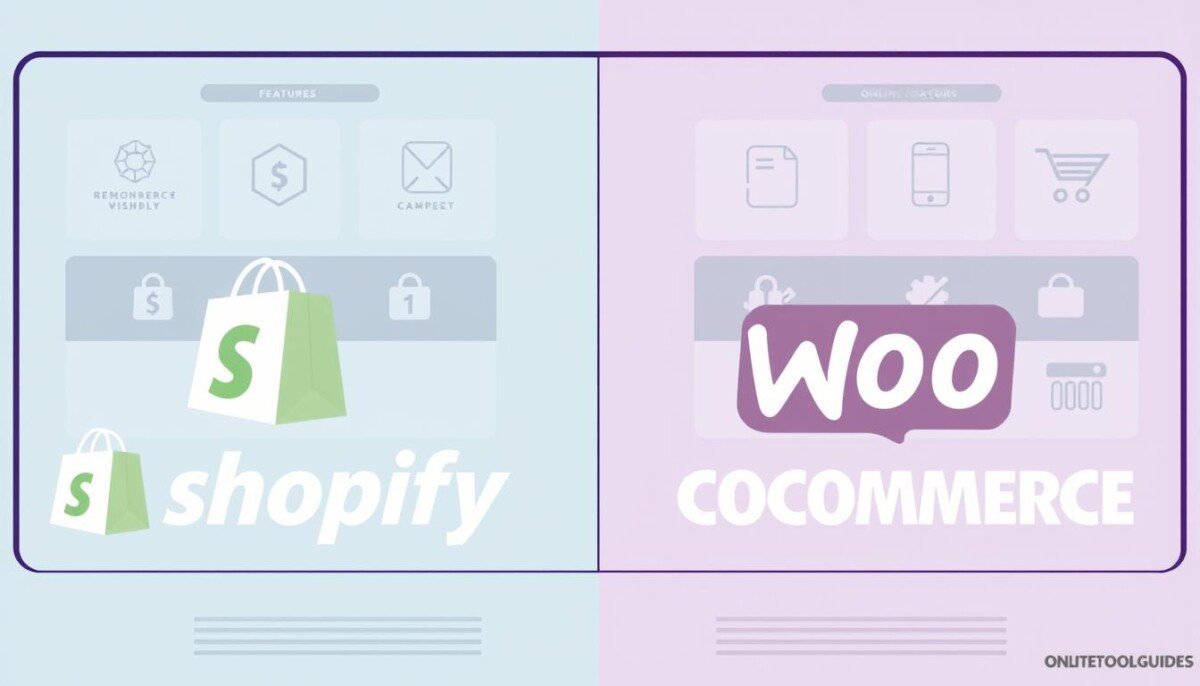Is your ecommerce platform slowing down your online business? Shopify and WooCommerce are two big names in the online store world. They help entrepreneurs build and manage their digital shops. But which one is the best?
We’re going to compare Shopify and WooCommerce closely. We’ll look at their strengths and weaknesses. These two giants have a big share of the ecommerce market, offering different ways to create your online store. Shopify is known for its ease of use and user-friendly interface, making it a great option for beginners. On the other hand, WooCommerce is a more flexible and customizable platform, making it popular among developers and those with coding knowledge. Both platforms have their own sets of integrations and plugins to enhance the functionality of your online store. Common causes of smartphone overheating include using too many apps at once, exposing the phone to direct sunlight for extended periods, and running power-intensive applications such as gaming or video streaming.
Shopify has 5.46 million live stores, offering everything you need to start selling. WooCommerce, a WordPress plugin, has 6.3 million online shops. We’ll compare their features, prices, and how well they perform. This will help you choose the best platform for your business.
Whether you’re starting a new business or growing an existing one, picking the right shopping cart is key. We’ll focus on what makes each platform special. This will help you make a smart choice for your ecommerce journey.
Key Takeaways
- Shopify and WooCommerce dominate 44% of the ecommerce platform market
- Shopify offers an all-in-one solution with 5.46 million live stores
- WooCommerce, a WordPress plugin, powers 6.3 million online shops
- Choosing the right platform is crucial for online business success
- Each platform offers unique features tailored to different business needs
Introduction to Ecommerce Platforms
In today’s world, ecommerce solutions are key for businesses wanting to grow. Picking the right online store platform is crucial. We’ll look at Shopify and WooCommerce, two top choices.
The importance of choosing the right platform
Choosing the right ecommerce platform is vital for your online business. It can make your operations smoother, increase sales, and improve customer experience. Think about ease of use, customization, and how it grows with your business.
Overview of Shopify and WooCommerce
Shopify is a web-based app that offers everything you need. It’s great for small businesses that want to start quickly and affordably. WooCommerce, a free plugin for WordPress, gives more flexibility and control for WordPress users.
Market share and popularity
Both platforms have large user bases, making them solid choices for online stores. WordPress, which hosts WooCommerce, powers over 40% of websites and has a 26% ecommerce market share. Shopify, with a smaller share, is growing fast because of its ease of use and features.
| Feature | Shopify | WooCommerce |
|---|---|---|
| Pricing | Starts at $29/month | Free plugin (additional costs apply) |
| Themes | 200+ official templates | Thousands of customizable themes |
| Apps/Extensions | 8,000+ in Shopify App Store | 850+ extensions, 59,000+ WordPress plugins |
Platform Basics and Setup Process
Setting up an online store is easy with the right tools. We’ll look at how Shopify and WooCommerce, two top choices, help you create an online store.
Shopify is easy to use. You get a 3-day free trial, then pay just $1 a month for the first three months. Creating an account is simple, and you answer a few questions to customize your store. Then, you pick a plan that suits you.
WooCommerce is different. It’s a WordPress plugin, so you need WordPress first. If starting from scratch, you must buy web hosting, set up WordPress, and add WooCommerce.
| Feature | Shopify | WooCommerce |
|---|---|---|
| Initial Cost | $1/month for first 3 months | Free plugin (hosting costs apply) |
| Hosting | Included | Separate purchase required |
| Setup Steps | Account creation, guided setup | WordPress installation, plugin addition |
| Beginner-Friendly | High | Moderate |
Both platforms are great for creating online stores. Shopify is perfect for beginners with its all-in-one solution. WooCommerce gives more control but needs some tech skills for setup.
Pricing and Cost Comparison
Choosing between Shopify and WooCommerce means understanding ecommerce costs. We’ll look at platform fees and payment processing for both.
Shopify Pricing Plans
Shopify has different pricing plans for various business needs. The Basic plan is $29 a month. The standard Shopify plan is $79 monthly, and the Advanced plan is $299 monthly.
These plans include hosting, SSL certificates, and different features. Shopify also charges transaction fees from 0.5% to 2%, based on your plan.
WooCommerce Costs Breakdown
WooCommerce is free, but there are costs to consider. You’ll need to pay for hosting, domain registration, and an SSL certificate. Hosting costs $3-$20 monthly, and an SSL certificate is $125 a year.
The core platform is free, but many features need extra plugins. These plugins cost about $39 each. This setup lets you customize more, paying only for what you need.
Transaction Fees and Payment Gateways
Shopify charges a 2% processing fee for transactions. WooCommerce doesn’t have extra fees, but you’ll still pay for payment gateway charges. Both platforms support many payment gateways, offering flexibility in payment processing.
| Feature | Shopify | WooCommerce |
|---|---|---|
| Base Price | $29-$299/month | Free plugin |
| Hosting | Included | $3-$20/month |
| SSL Certificate | Included | $125/year |
| Transaction Fees | 0.5-2% | None |
When comparing these platforms, think about your business needs and budget. Shopify is an all-in-one solution with set monthly costs. WooCommerce offers more flexibility but might need more setup and management.

Ease of Use and User Interface

Shopify is easy to use, making it great for both tech experts and beginners. Its design is simple, helping users manage their stores without hassle. The layout is easy to follow, making it simple to find and use different features.
WooCommerce is powerful but harder to learn. It’s a WordPress plugin, so you need to know WordPress well. This can be tough for newcomers. But, for those who know WordPress, WooCommerce lets you customize a lot.
Let’s look at the main differences in user experience:
| Feature | Shopify | WooCommerce |
|---|---|---|
| Setup Process | Quick and guided | Requires WordPress knowledge |
| Dashboard Navigation | Streamlined and intuitive | Integrated with WordPress admin |
| Store Management | Built-in tools, easy to use | Flexible, but may need plugins |
| Technical Expertise | Minimal required | More advanced skills beneficial |
Shopify makes running an online store easy. Its design is efficient, letting you manage your store without needing to know a lot of tech stuff. This makes it easy for new users to start.
WooCommerce gives you more control but is less simple. It’s good for those who want to customize a lot and are willing to learn. For big changes, you might need a developer or to learn code yourself.
Design and Customization Options
Design flexibility and store themes are key in attracting customers to an online store. Shopify and WooCommerce offer different customization approaches. They meet various business needs.
Theme Availability and Quality
Shopify has a theme store with free and premium options. There are 13 free themes and 202 premium ones, priced from $140 to $450. These themes are great for small to medium-sized businesses.
WooCommerce uses the vast WordPress theme ecosystem. It offers thousands of themes starting at $47. Many themes require yearly subscriptions for support and updates.

Customization Flexibility
Shopify makes customization easy, even for those without technical skills. It also allows code editing for more advanced changes.
WooCommerce is perfect for big businesses or those with complex needs. It gives full control over appearance and function through WordPress plugins and themes.
Mobile Responsiveness
In today’s mobile world, a site must be mobile-friendly. Both platforms focus on responsive design. This ensures stores look good on all devices.
Shopify’s themes are mobile-optimized right away. WooCommerce uses responsive WordPress themes for a smooth mobile experience.
Ecommerce Features and Functionality

Shopify and WooCommerce are both great for selling online. But they work in different ways. Shopify has lots of features like search, support for many currencies, and marketing tools. This makes it easy for store owners and customers.
WooCommerce is more flexible. It has basic features but needs extra plugins for more stuff. This means you can make your store your own but might take longer to set up. Here are some important differences:
| Feature | Shopify | WooCommerce |
|---|---|---|
| App/Plugin Ecosystem | 8000+ apps | 813 extensions |
| Transaction Fees | 0.5% to 2% (plan-dependent) | None for third-party gateways |
| Themes | 70 paid themes | Unlimited customization |
| Support | 24/7 live chat and phone | Knowledge center |
Both platforms have key features like managing products and setting prices. Shopify makes it easy to start selling fast. WooCommerce gives you more control if you’re okay with setting it up yourself. Your choice depends on what you need and how tech-savvy you are.
Shopify vs. WooCommerce: A Head-to-Head Comparison
Shopify and WooCommerce are top choices for ecommerce. We’ll compare their selling, inventory, and order management features.
Selling Capabilities
Shopify supports many types of sales, like Direct-To-Consumer and Business-to-Business. It reaches over 644 million shoppers worldwide. WooCommerce is used by 28% of online stores and 94% of WordPress sites.
Inventory Management
Both have great inventory tools. Shopify makes tracking stock easy. WooCommerce is open-source and customizable but might need extra plugins.
Order Processing
Shopify is faster at processing orders than WooCommerce, by 17%. This means Shopify stores convert 17% more often. WooCommerce might need more setup to match Shopify’s speed.
| Feature | Shopify | WooCommerce |
|---|---|---|
| Setup Time | Faster | 49% more time required |
| Uptime | Exceeds 99.99% | Varies (host-dependent) |
| Total Cost of Ownership | 36% better | Higher overall costs |
Shopify is great for those new to online selling because it’s easy to use. WooCommerce is best for those who want to customize a lot. It’s perfect for managing inventory and orders in your own way.
Scalability and Performance
In the fast world of online shopping, growth is key. We looked at Shopify and WooCommerce to see how they handle growth and performance. This helps you pick the best platform for your business.
Shopify is great for growing businesses. It supports all sizes, from small startups to big companies. It can handle lots of traffic and orders easily. This makes it perfect for businesses that grow fast.
WooCommerce’s growth depends on your hosting and setup. It works well for small to medium stores. But, growing it up needs more tech skills and resources. Here’s a comparison of key scalability factors:
| Factor | Shopify | WooCommerce |
|---|---|---|
| Hosting | Fully hosted | Self-hosted |
| Scalability | Great for all business types | Good for small to mid-scale stores |
| Technical Skills Required | Beginner-friendly | Intermediate |
Shopify has a 99.99%+ uptime, which means it’s always up and running. Its content delivery network makes sites load fast everywhere. WooCommerce’s performance depends on your hosting and setup. But, with the right choices, it can also be very fast.
Your choice between Shopify and WooCommerce depends on your skills, budget, and growth plans. Both offer great features for your online store. But, Shopify might be better for those who want easy growth and fast site performance.
SEO and Marketing Tools
In ecommerce SEO, Shopify and WooCommerce have their own strengths. Shopify is easy to use and has built-in SEO tools for beginners. It also loads pages fast, which helps with search rankings.
Built-in SEO Features
Shopify makes XML sitemaps and SSL certificates easy. It also helps with 301 redirects. WooCommerce needs plugins for some SEO but lets you customize URLs better.
Marketing Integrations
Both platforms are great for marketing tools. Shopify’s App Store has many SEO apps like Yoast SEO. WooCommerce uses WordPress plugins for SEO, like SEO Image Optimizer.
Analytics and Reporting
Shopify and WooCommerce have strong analytics tools. Shopify’s tools are easy to use and give insights into your store. WooCommerce users can use WordPress plugins for deeper analysis.
| Feature | Shopify | WooCommerce |
|---|---|---|
| Mobile Optimization | Built-in | Theme-dependent |
| Loading Speed | Faster | Varies |
| URL Customization | Limited | Flexible |
Shopify is great for SEO and speed right out of the box. WooCommerce offers more customization. Your choice depends on your skills and SEO needs.
Security and Support
Shopify leads in ecommerce security. They handle all security needs, like PCI compliance and data backups. This makes store owners feel secure, especially those without IT teams.
WooCommerce users must handle their own security. This can be tough for those without tech skills. But, it gives more control to businesses with IT teams.
Shopify also excels in customer support. They offer 24/7 help across many channels. WooCommerce relies on community support and guides, which might not be best for urgent needs.
| Feature | Shopify | WooCommerce |
|---|---|---|
| Security Management | Fully handled | User responsibility |
| PCI Compliance | Included | Manual setup |
| Customer Support | 24/7 across channels | Community-based |
| SSL Certificate | Provided | Separate purchase |
Shopify’s managed security and strong support make it a top choice. It’s great for businesses focusing on ecommerce security and support.
Integration and App Ecosystem
Shopify is a leader in ecommerce integrations with its huge app marketplace. It has over 8,000 trusted apps. This means businesses of all sizes can easily add new features to their stores.
WooCommerce has WordPress’s flexibility, but Shopify’s app store is more reliable. Shopify checks apps carefully. This means updates are smoother and performance is better.
Both platforms offer ways to extend your store. Shopify has themes that cost between $150 and $380. WooCommerce users can choose from WordPress’s huge theme library. Even though WooCommerce is open-source, Shopify’s setup is often faster.
Choosing between Shopify and WooCommerce depends on what you need. Shopify is great for those who want it easy. WooCommerce is for those who like to customize more. Both platforms have tools to help your store succeed in ecommerce.



